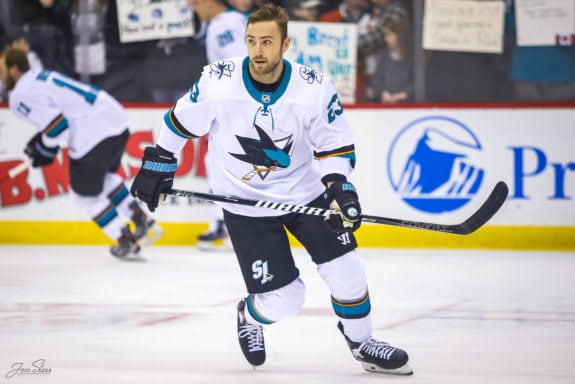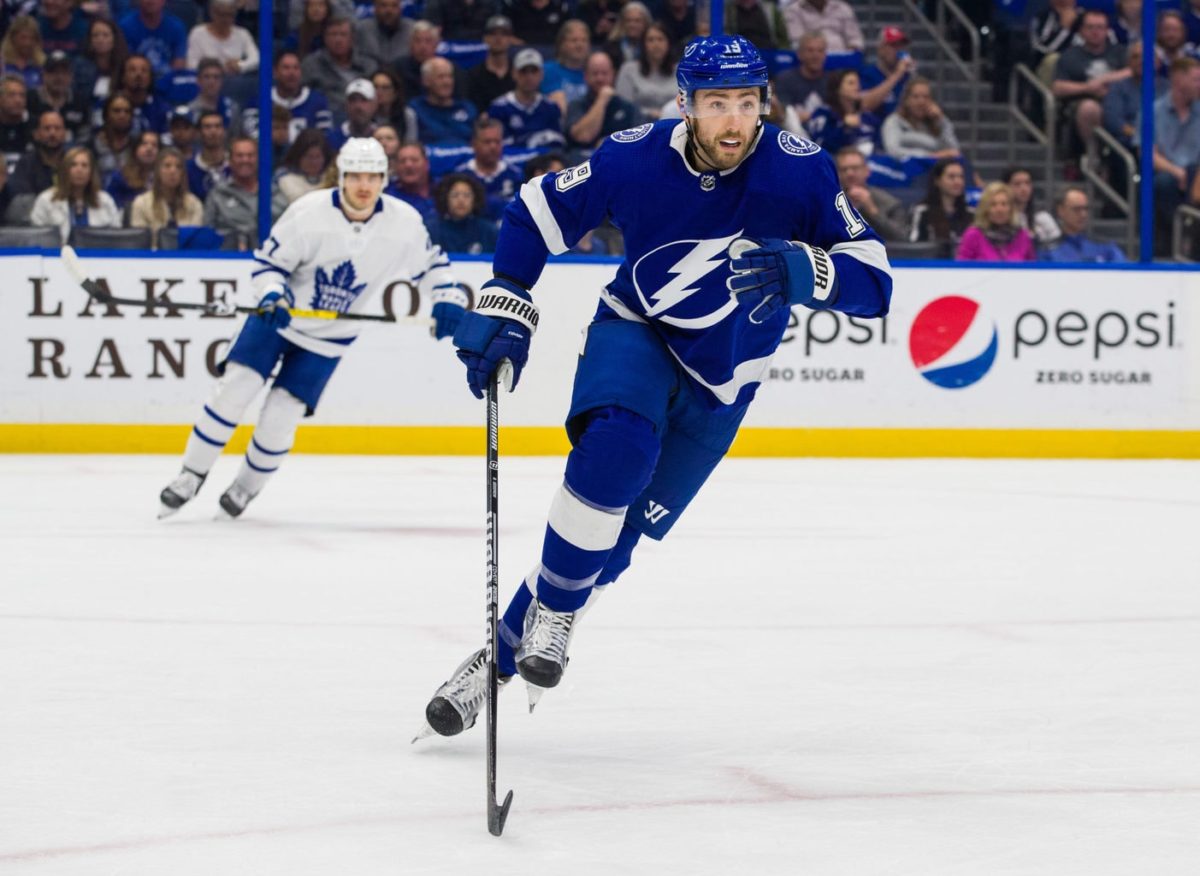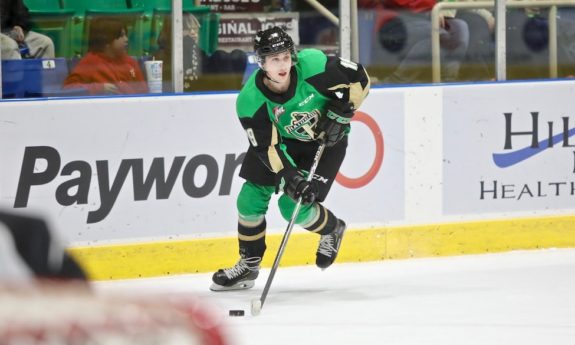After Tampa Bay Lightning general manager Julien BriseBois pulled off a blockbuster trade for Blake Coleman about two weeks days before the 2020 trade deadline, it felt like that would be all for the team. Sure they still had their own first-round pick in the upcoming draft, but between that big trade and signing defenseman Zach Bogosian as a free agent, there wasn’t a lot left that the Lightning desperately needed to shore up their roster for the postseason.
Read Also: Revisiting the Lightning’s Blockbuster Trade for Blake Coleman
However, as we now know, BriseBois was not content to rest on his laurels at this deadline. After working the phones into the waning minutes, he eventually pulled off one last unexpected deal which sent Tampa Bay’s 2020 first-round pick and prospect Anthony Greco to the San Jose Sharks for forward Barclay Goodrow and a 2020 third-rounder.
The initial reaction to this trade was confusion for many Lightning fans, as Goodrow wasn’t a household name outside of San Jose. Sure he was a defensive, big-bodied, physical forward that fit the bill for everything you want to take on a long postseason push, but he wasn’t someone that you would expect to pay a first-round pick for.

Once you dug deeper into the trade, however, you quickly understood why BriseBois paid a premium price for Goodrow. First, he was on a low-cost $925,000 contract that lasted until the 2021 offseason, which gave the Lightning two years of service below market value. For a team deep in a cap crunch, that sort of cap flexibility was invaluable.
Secondly, the Lightning returned the Philadelphia Flyers’ 2020 third-round pick in the deal with San Jose, meaning that they were actually only moving down in the draft. Even in the worst-case scenario, the pick would have been 93rd overall, which still has a lot of value. So this trade didn’t just return a great player on an incredible contract, but it still left BriseBois with another pick to use or trade at the draft.
Goodrow Helped Reshape Lightning Into a Contender
Before anyone could even think about the 2020 Draft, however, the Lightning had to get through the postseason. While this process was heavily delayed, when Goodrow eventually made his full-time debut, he was an instant hit alongside Coleman and Yanni Gourde.
This third line changed how Tampa Bay played in the postseason. They were a battery for the team, whose presence on the ice could change the flow of a game.
Did the team come out flat? Throw out the third line to generate a few chances, lay down some hits and wake up the bench. Was the team being pressured and stuck in their own zone? The third line could slow things down, make a few smart plays with the puck, and help push play back up the ice. Was there a penalty? Well, Goodrow was a top penalty killer for the Lightning, averaging the third-most ice time while short-handed.
This line did everything, and Goodrow was instrumental in its construction. There’s a reason why he was on the ice as the Lightning closed out Game 6 to win the Stanley Cup, as he could keep the puck safe and on the winning path.

Following this success, Goodrow entered the 2020-21 season ready to be a key part of the Lightning. While he scored a solid six goals and 20 points, more importantly, he continued to be that needed defensive specialist. He had the second most time on the penalty kill, went a team-best plus-16, led the team with 111 hits, and even had the sixth most takeaways.
This play continued in the postseason, where he started in 18 games, five fewer than the 23 it took to win the Stanley Cup, but still was in the top three for hits and was a leader on the penalty kill. Once again, his play wasn’t sexy, but it was perfectly balanced the Lightning’s high-end skill and it helped push them over the top to back-to-back championships.
Finally, before the Seattle Kraken expansion draft, Goodrow’s rights were traded to the New York Rangers for a 2022 seventh-round pick, where he signed a well-earned six-year, $21.85 million contract.
What the Lightning Lost (And Gained) for Goodrow
For what ended up being the perfect addition to their roster, the Lightning gave up their 2020 first-round pick, which landed 31st overall. With this pick, San Jose selected Ozzy Wiesblatt, who was a highly-skilled forward that had the toolkit to become a top-six dynamo with the proper development.
In the two seasons following his selection, Wiesblatt has been an excellent player for the Prince Albert Raiders of the Western Hockey League (WHL), despite his playing time being limited. In 23 games played throughout 2020-21, he posted seven goals and 28 points, where in 2021-22, he has nine goals and 34 points in 37 games. He also played six games with the Sharks’ AHL team, the San Jose Barracuda, where he scored three points.

However, while they gave up the 31st overall pick in this trade, the Bolts still returned a third-rounder which ended up 85th overall. With this selection, the Lightning took Maxim Groshev, a big-bodied forward who took on 36 games in the Kontinental Hockey League (KHL) despite his young age.
Throughout the 2020-21 and 2021-22 seasons, Groshev bounced around the various levels of professional hockey throughout Russia. He played in 28 KHL games combined and has landed a more consistent role in the Russian minor league system, scoring 12 points in 16 games.
So, is there a clear difference in pedigree between Wiesblatt and Groshev? Yes. But for the Lightning, the fact that they still got a solid prospect out of this deal alongside Goodrow makes the trade look even better.
Lightning Made the Right Choice With Goodrow
For BriseBois and the Lightning, the 2020 deadline was a make-or-break moment. While he had only been a general manager for a little over a year at the time, he took some big chances and went all-in with a move to bring in an unexpected talent for his roster.
Read Also: NHL Rumors: Flyers, Oilers, Maple Leafs, Rangers, Canadiens, Predators
Looking back at the Goodrow deal, it really was a great trade for the Lightning. First, they got the exact player they needed to win not only in 2020, but also had a cost-controlled asset to carry forward into 2021, where he once again helped them win it all. Not only that, but they returned a mid-value draft pick which turned into a solid prospect for the franchise. If Groshev eventually develops into a starter for Tampa Bay, then it would make this a perfect deal.
For now, though, it is this sort of unexpected move that showcases why it isn’t always the flashiest deals on deadline day that ultimately make the biggest impacts on the ice.